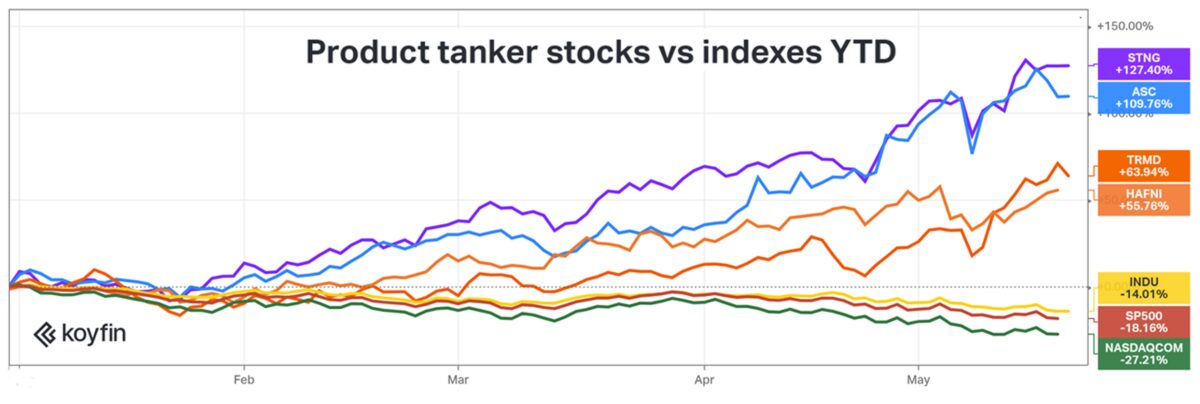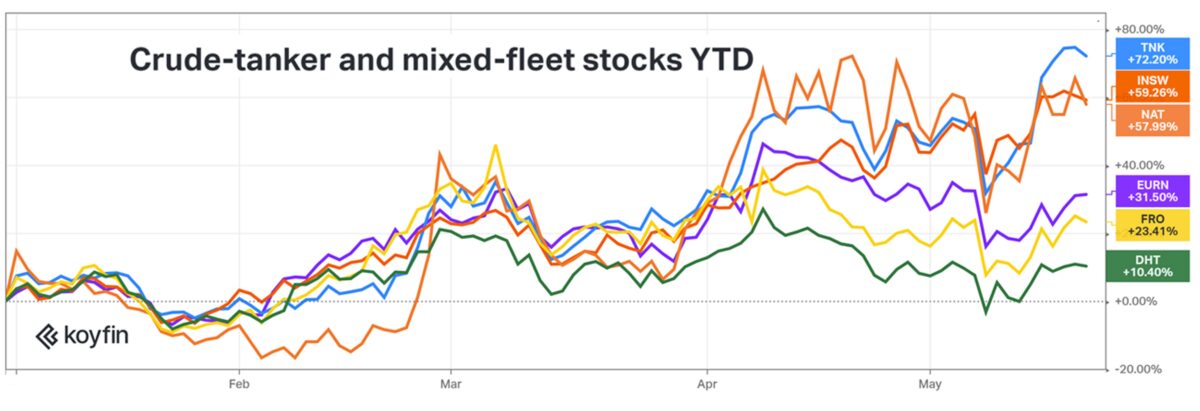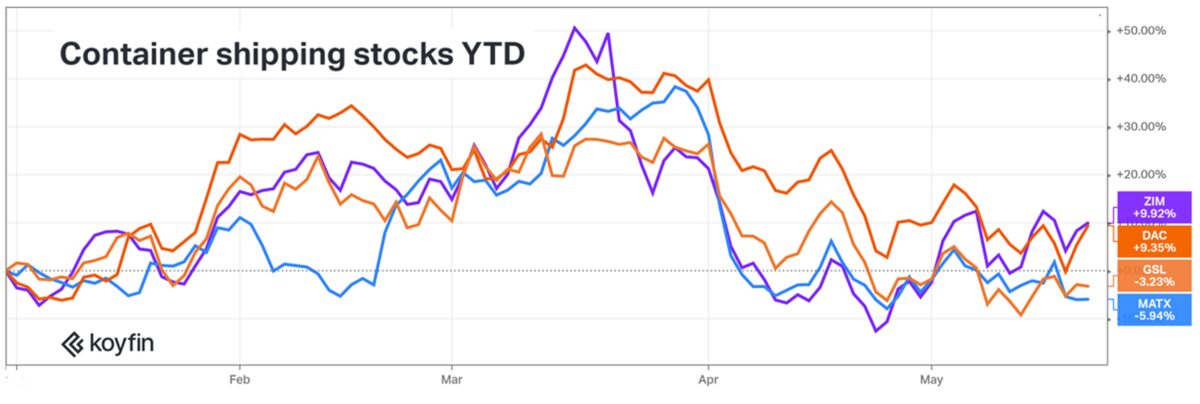The Nasdaq composite is down 27% since the beginning of the year, the S&P 500 18%, the Dow 14%. And then there’s commodity shipping. Despite a few rough trading sessions along the way, commodity shipping stocks are up high double digits year to date. In some cases, triple digits.
“The earnings power of these [commodity shipping] companies is going in the opposite direction,” explained Ben Nolan, shipping analyst at Stifel. “Dry bulk and tanker rates are really good, compared to something like trucking rates.”
Product tanker stocks
Owners of product tankers, the vessels that carry cargoes such as diesel and gasoline, are performing particularly well. Shares of Scorpio Tankers (NYSE: STNG) are up 127% YTD as of Friday’s close. Ardmore Shipping (NYSE: ASC) is up 110%. Ardmore hit a 52-week high on Wednesday, Torm (NASDAQ: TRMD) on Thursday.

Modern-built medium-range (MR) product tankers — the kind that typically load exports of diesel and gasoline in the U.S. Gulf — were earning $55,300 per day in the spot market on Friday, according to Clarksons. That’s five times what they earned on average in 2021.
“If you can give me $30,000 a day for the full year [for MRs], that would be incredible,” said Liam Burke, shipping analyst with B. Riley Securities. Even at levels he expects, in the mid- to low 20s, “you’re going to see some very nice cashflow and benefit to shareholders through reduction in debt, where the enterprise value goes to the equity holder, or more buybacks and dividends.”
Nolan cited share upside from the war. “I don’t think it’s lost on people that tankers are a beneficiary of what’s going on in Russia and Ukraine. And that doesn’t seem like it’s going to be turning around anytime soon. If Europe is going to become more independent [of Russian supplies] and the U.S. is to become the energy savior of the world, that’s good for the tanker market.”
Nolan pointed out that in 2021, product tanker shares traded at a steeper discount to net asset value (NAV, the value of ships and other assets, minus liabilities) than crude tanker shares. Product tanker shares “are coming from a lower starting point and they’ve closed the gap [between share price and NAV],” he said.
The value of product tankers themselves is also rising in the secondhand market, which increases the owner’s NAV. “NAVs are rising pretty quickly and will continue to do so, for no other reason than these companies are making a lot of money,” said Nolan.
Product tanker stocks “are trading close to fair value, but not at substantial premiums to NAV, in a world where NAVs are rising,” he said.
Dry bulk shipping stocks
Owners of bulkers — the ships that carry cargoes such as iron ore, coal, grains and minerals — are also posting big stock gains. Golden Ocean (NASDAQ: GOGL) is up 67% YTD, Grindrod (NASDAQ: GRIN) 59%, Eagle Bulk (NASDAQ: EGLE) 48%, Genco Shipping & Trading (NYSE: GNK) 42% and Star Bulk (NASDAQ: SBLK) 41%.
Grindrod and Star Bulk hit a fresh 52-week high on Friday, Golden Ocean on Thursday.

Rates for larger bulkers known as Capesizes (with capacity of around 180,000 deadweight tons or DWT) had previously lagged smaller bulker classes but have now jumped ahead. Clarksons put Friday’s Capesize spot rate at $37,500 per day, up 232% month on month. Rates for Panamaxes (65,000-90,000 DWT) are at $30,300 per day. Rates for Supramaxes (45,000-60,000 DWT) are at $30,800 per day.
Burke sees upside for dry bulk demand from the Russia-Ukraine war, as Europe bans imports of Russian coal and sources it from more distant sources. (Vessel demand is measured in ton-miles — volume multiplied by distance — so longer voyage distance increases demand.)
“Coal has traditionally been net neutral [for bulker demand] and has become a major positive,” he said.
Nolan expects Chinese demand for iron ore (used for steel production) to bounce back with the end of COVID lockdowns, which should support Capesize rates.
“If dry bulk rates can hang on at an average of $30,000, maybe a little more for Capes and a little less for smaller ships, these companies are going to make a ton of money,” said Nolan.
“Star Bulk has a floating dividend policy. At these kinds of rates, it could pay out $8 or $10 in dividends. If the stock is at $30, and if the share price doesn’t go up, although I suspect it probably would, you’d get a 30% yield on your position with those kinds of dividends, even in the absence of capital appreciation.”
Crude tanker, mixed-fleet stocks
Product tanker rates have outperformed crude tanker rates this year. Even so, crude tanker stocks are doing much better than the broader stock indexes. Nordic American Tankers (NYSE: NAT) is up 58% YTD, Euronav (NYSE: EURN) 32% and DHT (NYSE: DHT) 10%.
Shares of companies that own both crude and product tankers are doing better than pure crude tanker owners. Teekay Tankers (NYSE: TNK) is up 72% YTD, International Seaways (NYSE: INSW) 59% and Frontline (NYSE: FRO) 23%.
Teekay Tankers hit a new 52-week high on Friday, International Seaways on Wednesday.

Since the war broke out, smaller crude tankers have significantly outperformed larger tankers. Modern-built Aframaxes (tankers with capacity of 750,000 barrels of crude) were earning spot rates of $28,800 per day as of Friday, according to Clarksons. Rates for Suezmaxes (1 million barrels) were $17,200 per day. Rates for very large crude carriers (VLCCs, 2 million barrels) were just $7,100 per day.
“The reason is that there are no Russian ports that can load a VLCC,” said Nolan. “If Russia’s going to be exporting crude much further distances [instead of to Europe], it will have to go on Aframaxes and Suezmaxes.”
Container shipping stocks
Container shipping remains by far the most profitable of all shipping segments. Yet container shipping shares are under the most pressure, because they’re most directly exposed to consumer sentiment toward inflation, and spot freight rates are off their peaks.
Container shares are now well below mid-March highs and have given back much if not all of their gains YTD. However, they’re still outperforming the broader stock market. Among liner operators, Zim (NYSE: ZIM), which just reported its best quarter in history, remains up 10% YTD. Matson (NYSE: MATX) is down 6%.
Among ship lessors, Danaos (NYSE: DAC) is still up 9%, and Global Ship Lease (NYSE: GSL) is down 3%.

“Our view is that we’ve seen the peak in rates,” said Nolan. “The real question is the slope of the line and how steep [the decline is]. I have a view that the slope is going to be somewhat steeper than my counterparts do.
“From a share price perspective, it’s tricky. Because if you’re of the opinion that the market is softening, it’s hard to buy a stock. The other big concern is the orderbook [for new container ships]. When I look at the orderbook for 2023 and 2024, I just roll my eyes and think, ‘Here we go again.’”
“On the flip side, these companies are making so much money,” Nolan said. If freight and charter rates don’t fall too much in the second half, container stocks would be “trading at tiny fractions of what a normal [price-to-earnings] multiple is and the cash generated would be transformative to balance sheets.”
Burke sees further upside for container shipping stocks. Even if spot rates ease, stocks could trade at higher multiples if investors conclude that elevated profit conditions will last longer than they currently expect. Underscoring the potential longevity of the boom, Global Ship Lease recently secured a 48- to 52-month charter for one of its ships that doesn’t even begin until July 2023 — over a year from now.
“The liners’ balance sheets have never been in better shape,” said Burke. “For companies leasing ships to liner companies, counterparty risk is pretty much off the table. Yes, spot rates are starting to come off, but they’re coming down from very elevated levels and the risk has declined significantly for the whole structure of the container business.”
Click for more articles by Greg Miller
Related articles:
- The world is ‘crying out for diesel.’ Product tankers could win big
- Blockbuster container shipping results collide with sinking sentiment
- Commodity shipping stocks are trouncing Dow transport average
- Container shipping rates: Still sky high but falling back to Earth
- Has the peak of container shipping’s epic boom already passed?
- Despite rising risks, shipping lines on track for another record year
- How invasion of Ukraine could ease shipping logjam off US ports
- Shipping stocks take another beating, sinking by double digits











